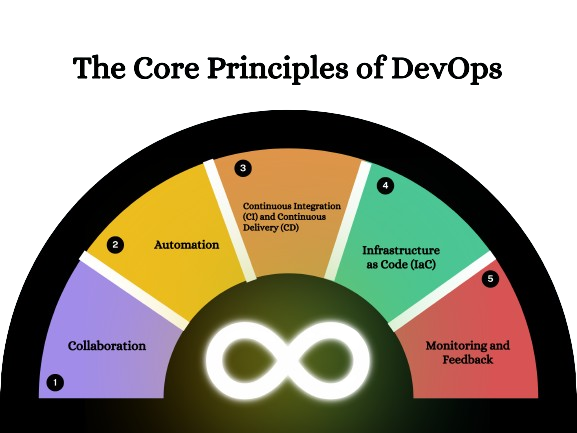In today’s fast-paced digital landscape, traditional software development methodologies struggle to keep up with the demands of rapid deployment, scalability, and reliability. Enter DevOps, a revolutionary approach that bridges the gap between development and operations teams, enabling organizations and DevOps service providers to deliver high-quality software at unprecedented speed. In this comprehensive guide, we’ll delve deep into the world of DevOps, exploring its principles, practices, benefits, and implementation strategies.
Understanding DevOps Methodology
DevOps, a portmanteau of “Development” and “Operations,” is not just a set of practices or tools; it’s a cultural shift that fosters collaboration, communication, and automation across the entire software development lifecycle. At its core, DevOps aims to break down silos between development, operations, and quality assurance teams, promoting continuous integration, continuous delivery, and continuous monitoring. amet, consectetur adipiscing elit. Ut elit tellus, luctus nec ullamcorper mattis, pulvinar dapibus leo.
The Core Principles of DevOps

Collaboration: DevOps emphasizes the importance of collaboration and communication between development, operations, and other stakeholders involved in the software delivery process. By fostering a culture of shared responsibility and accountability, teams can work together seamlessly to achieve common goals.
Automation: Automation lies at the heart of DevOps, enabling organizations to streamline repetitive tasks, accelerate deployment cycles, and improve overall efficiency. From code integration and testing to deployment and monitoring, automation eliminates manual errors and enhances productivity.
Continuous Integration (CI) and Continuous Delivery (CD): CI/CD practices enable teams to deliver code changes more frequently and reliably. By integrating code changes into a shared repository and automating the testing and deployment process, organizations can reduce the time between code commits and production releases, ultimately delivering value to end-users faster.
Infrastructure as Code (IaC): IaC treats infrastructure configuration as code, allowing teams to manage and provision infrastructure resources programmatically. By defining infrastructure requirements in code, organizations can achieve consistency, scalability, and repeatability, reducing the risk of configuration drift and human error.
Monitoring and Feedback: Continuous monitoring and feedback loops are essential components of DevOps, providing visibility into application performance, infrastructure health, and user experience. By collecting and analyzing metrics, teams can identify bottlenecks, detect anomalies, and make data-driven decisions to optimize system performance and reliability.
Benefits of Adopting DevOps

Accelerated Time to Market: DevOps enables organizations to release new features and updates faster, allowing them to respond to market demands and customer feedback more effectively. By streamlining the software development lifecycle, DevOps minimizes bottlenecks and delays, facilitating rapid iteration and deployment. This agility not only helps organizations stay ahead of competitors but also allows them to seize new opportunities and capitalize on emerging trends in the market. Furthermore, accelerated time to market can lead to increased customer satisfaction and loyalty, as customers receive value sooner and more frequently.
Improved Collaboration and Communication: By breaking down silos and promoting cross-functional collaboration, DevOps fosters a culture of shared ownership and accountability, leading to better teamwork and alignment. Collaboration between development, operations, and other stakeholders ensures that everyone has a voice in the software delivery process and understands their role in achieving organizational goals. Enhanced communication channels, such as regular stand-up meetings, collaborative tools, and shared dashboards, facilitate transparency and information sharing, enabling teams to make informed decisions and address challenges more effectively. As a result, organizations can deliver higher-quality software products that meet both business and user requirements.
Enhanced Quality and Reliability: Automation and continuous testing practices inherent in DevOps help ensure software quality and reliability, reducing the likelihood of defects and downtime in production environments. By automating repetitive tasks such as code compilation, testing, and deployment, DevOps minimizes human error and accelerates the feedback loop, allowing teams to identify and address issues early in the development process. Continuous integration and continuous delivery pipelines enable teams to deliver small, incremental changes to production frequently, reducing the risk of introducing bugs and regressions. Additionally, automated monitoring and alerting systems provide real-time visibility into application performance and health, enabling teams to proactively detect and remediate issues before they impact end-users.
Increased Scalability and Flexibility: DevOps practices such as infrastructure as code and cloud-native architectures enable organizations to scale resources dynamically and adapt to changing business requirements more efficiently. Infrastructure as code allows teams to define and provision infrastructure resources programmatically, enabling consistent and repeatable deployments across different environments. Cloud-native architectures leverage cloud services and microservices-based architectures to build highly scalable and resilient systems that can handle fluctuations in demand and workload. By embracing DevOps principles, organizations can avoid costly overprovisioning of resources and instead allocate resources based on actual usage and demand, resulting in cost savings and improved resource utilization.
Cost Optimization: By optimizing resource utilization, streamlining processes, and reducing manual intervention, DevOps can lead to cost savings and improved return on investment (ROI) for organizations. Automation eliminates manual, error-prone tasks and reduces the need for dedicated personnel to manage infrastructure and deployments, resulting in operational efficiencies and lower labor costs. Additionally, DevOps practices such as infrastructure as code and cloud-native architectures enable organizations to leverage pay-as-you-go pricing models and scale resources based on demand, avoiding upfront capital expenditures and reducing overall infrastructure costs. Furthermore, improved collaboration and communication between teams can lead to faster decision-making and reduced rework, minimizing project delays and budget overruns. Overall, adopting DevOps can help organizations optimize their IT spend and allocate resources more effectively to drive business growth and innovation.
Implementing DevOps: Best Practices and Strategies
Cultural Transformation: DevOps adoption requires a cultural shift, with leadership buy-in and support playing a crucial role in driving organizational change. Encourage a culture of experimentation, learning, and continuous improvement to foster innovation and resilience.
Toolchain Selection: Choose the right set of tools and technologies that align with your organization’s goals and requirements. From version control and CI/CD pipelines to monitoring and collaboration platforms, invest in tools that promote automation, collaboration, and visibility.
Skills Development: Invest in training and upskilling your teams to equip them with the necessary knowledge and expertise to embrace DevOps practices effectively. Encourage cross-functional collaboration and knowledge sharing to build a cohesive and empowered workforce.
Incremental Adoption: Start small and iterate gradually, focusing on incremental improvements and measurable outcomes. Identify key areas for improvement and prioritize initiatives based on business impact and feasibility.
Continuous Learning and Improvement: Embrace a culture of continuous learning and improvement, encouraging teams to experiment, fail fast, and learn from mistakes. Celebrate successes and milestones, while also acknowledging and addressing challenges along the way.
Conclusion
In conclusion, DevOps methodology represents a paradigm shift in software development, emphasizing collaboration, automation, and continuous improvement. By breaking down silos, embracing automation, and fostering a culture of innovation, organizations can accelerate their digital transformation journey and deliver value to customers more efficiently. As businesses increasingly rely on technology to drive innovation and competitive advantage, embracing DevOps becomes essential for staying ahead in today’s digital economy.
In need of expert guidance to implement DevOps methodology effectively? Consider partnering with a reputable DevOps Consulting service or exploring DevOps as a service offerings to leverage industry best practices and accelerate your DevOps journey.
With the right approach and mindset, DevOps has the potential to revolutionize how organizations build, deploy, and manage software, paving the way for faster innovation, greater resilience, and enhanced customer experiences in the digital age.
This comprehensive guide provides a solid foundation for understanding DevOps and its transformative impact on modern software development. By embracing DevOps principles and practices, organizations can unlock new levels of agility, efficiency, and competitiveness in today’s rapidly evolving digital landscape.


